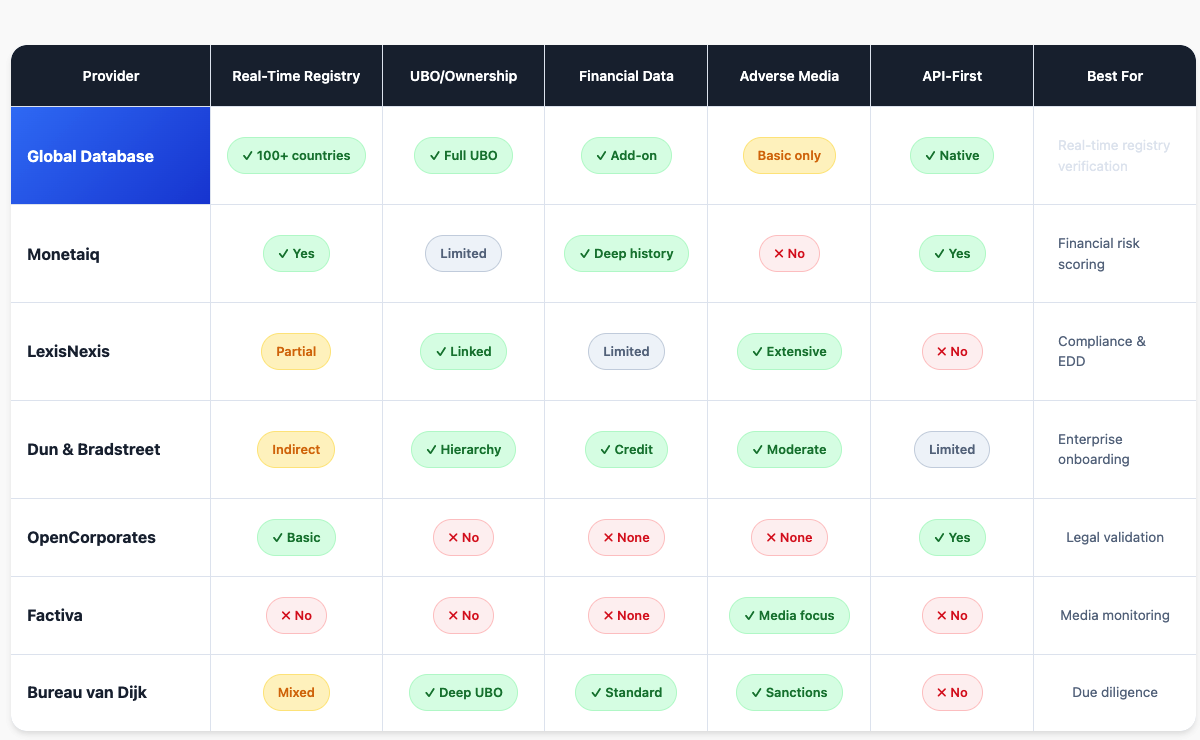
How to Normalize Firmographic Data Across 150+ Countries (Without Losing Your Mind)
1. Introduction
Normalizing firmographic data across 150+ countries isn’t just a data challenge — it’s a structural problem that breaks CRMs, onboarding flows, and segmentation logic at scale.
Every country has its own registry format. Legal forms vary wildly. Industry codes don’t align. Even basic fields like company status or employee count come in inconsistent formats — or not at all.
If you’re working with global B2B data, cleaning this manually isn’t just painful — it’s impossible.
That’s where Zephira.ai comes in. We help developers and product teams instantly normalize company data — from legal form to revenue, industry classification to social media profiles — using clean, real-time data sourced directly from official registries.
This guide unpacks how to normalize firmographic data across borders, what pitfalls to avoid, and how Zephira automates the entire process without wasting dev cycles on duct tape and data hacks.
2. What Is Firmographic Data?
Firmographic data includes the foundational building blocks of any business profile. These attributes go far beyond just the company name or industry classification — they give context, segmentation power, and operational intelligence across your stack.
Here are the most common firmographic attributes normalized by Zephira.ai:
| Attribute | Description |
|---|---|
| Legal Name | Official registered name of the company |
| Trading Name / Alias | Commercial name used in the market (if different) |
| Registration Number | Unique identifier issued by a national registry |
| Legal Form | Type of entity (e.g. Ltd., GmbH, LLC, PLC) |
| Status | Registration and trading status (e.g. active, dissolved) |
| Incorporation Date | Date the entity was established |
| Industry Classification | Categorized via NACE, SIC, NAICS, or Zephira’s mapped schema |
| Industry Tags | Smart keyword-level segmentation for targeting and enrichment |
| Revenue Estimate | Last available or modeled annual turnover (currency normalized) |
| Employee Estimate | Actual or estimated headcount |
| Company Website | Verified URL from registry or enriched via web scan |
| Business Description | Short summary of the company’s activities and focus |
| Company Logo | Logo file link (useful for dashboards or CRM cards) |
| Social Media Profiles | Verified LinkedIn, Twitter, Facebook, etc. |
| Phone Number | Enriched or registry-sourced main contact number |
| Email Address | General inquiry or sales contact email |
| Country / City / Address | Standardized physical location of HQ or main branch |
Zephira ensures that all these data points are cleaned, deduplicated, and normalized across more than 150 countries — accessible via real-time API or batch export.
3. The Chaos of Global Company Data
Global firmographic data is a mess — and every country introduces its own layer of complexity.
Take something as simple as a company’s legal form. In the UK it’s “Ltd,” in Germany it’s “GmbH,” in Brazil “LTDA,” and in France “SARL.” They all mean the same thing — Private Limited Company — but appear in wildly different formats.
Industry classification is even worse. Some registries use NAICS. Others use NACE, SIC, or their own custom codes. Mapping them manually requires thousands of crosswalk rules — and that’s before you factor in spelling errors, abbreviations, and character encoding issues.
Other common pain points:
- Statuses like “Active,” “Good Standing,” or “Registered” can mean different things — or nothing at all.
- Business names come in multiple languages or include legal suffixes that must be stripped out for deduplication.
- Employee and revenue figures may be missing, outdated, or presented in different currencies and ranges.
What looks like a clean list of companies at first glance quickly turns into an unmanageable swamp of inconsistent, incompatible data.
Zephira.ai handles this complexity behind the scenes — giving you clean, normalized firmographics with every API call, no matter where the company is registered.
4. The Hidden Cost of Poor Normalization
When firmographic data isn’t normalized, it silently breaks your most critical workflows — often without you realizing the root cause.
Here’s what poor normalization really costs:
- Broken SegmentationYou try to build an ICP segment of “Private Limited Companies with 50–500 employees.” But because legal forms and employee bands aren’t standardized, your filters miss half the target accounts — or include the wrong ones.
- Duplicate Records“ACME Ltd,” “ACME Limited,” and “ACME GmbH” get treated as separate companies. Your CRM fills up with conflicting records, lost context, and frustrated sales teams.
- Compliance FailuresIf your KYB flow can’t interpret country-specific legal forms or verify status from different registries, you risk onboarding inactive or non-existent entities — or worse, triggering a false positive you can’t clear.
- Wasted Dev TimeEngineering teams end up building patchwork scripts to handle edge cases for every country. The result? More technical debt, slower product launches, and brittle logic that breaks anytime a registry changes format.
Poor data doesn’t just cause bad outcomes — it erodes trust in your product and platform. And the more countries you support, the more the chaos compounds.
Zephira.ai solves this by delivering normalized, registry-verified firmographic data that’s ready to plug into your systems — no duct tape required.
5. Normalization Challenges at Scale
It’s one thing to clean a dataset from one country. It’s another to normalize firmographic data across 150+ countries — in real time, with zero tolerance for inconsistency.
Here are just a few of the challenges teams face at scale:
- Inconsistent Legal FormsA single field like “legal form” can appear in hundreds of local variants — GmbH, Ltd, SARL, LLC, Pte. Ltd., Sp. z o.o. — each with different abbreviations, punctuation, and languages. Normalizing them to a global standard requires deep country-specific logic.
- Varying Definitions of “Active”Some registries list a company as “Registered,” others use “Trading,” “Operating,” or “Good Standing.” But not all of these mean the company is actually active. Without a unified status model, you risk onboarding dormant or dissolved entities.
- Multiple Industry Code SystemsNAICS, NACE, SIC, local codes — and often, custom internal tags. Mapping across them without introducing overlap or losing granularity is a major data engineering challenge.
- Multi-language and Unicode IssuesGlobal company names and descriptions may include accented characters, Cyrillic, or non-Latin scripts. Without proper normalization and transliteration, you’ll miss duplicates or misclassify records.
- Incomplete or Outdated FieldsMany registries omit key firmographics like revenue or employee numbers — or only update once a year. This makes real-time decisioning impossible without enrichment.
Most teams try to solve this with a patchwork of scripts, manual tagging, and brittle logic — until the system breaks under the weight of international edge cases.
At Zephira, we’ve built our platform to absorb this complexity so your team doesn’t have to. Every record we deliver is normalized, enriched, and aligned to a unified schema — out of the box.
6. Zephira.ai’s Approach to Normalization
Zephira was built from the ground up to solve this problem — not just deliver raw data, but clean, schema-aligned, enriched firmographics in real time.
Here’s how we do it:
- Registry-sourced only: No scraped data, ever. We connect directly to 100+ official government registries.
- Unified schema: Every record we deliver conforms to a strict field structure, with global standards applied.
- Mapped industry codes: We intelligently map between NAICS, SIC, NACE, and local codes so you don’t have to.
- Legal form standardization: All legal types are mapped to 1 of 18 normalized types (e.g. Private Limited, Public Company, NGO).
- Real-time API delivery: Query and enrich company data on-demand, at the point of need — no stale data or bulk CSV uploads.
- Built-in enrichment: Where registries lack fields (e.g. website, size estimates), we enrich using verified sources.
We go beyond core registry fields. Zephira also enriches firmographic profiles with verified:
- Websites
- Social media handles
- Logos
- Descriptions
- Industry-specific tags
- Revenue and employee estimatesSo you don’t just get verified identity — you get actionable company intelligence.
7. Example: Normalizing Legal Form Across 5 Countries
Let’s look at one of the most common — and deceptively complex — firmographic fields: legal form.
While a “Private Limited Company” may sound simple, its representation differs drastically by country. Without normalization, your systems treat them as unrelated entities — breaking segmentation, compliance rules, and deduplication logic.
Here’s how Zephira.ai maps local legal form types into a unified schema:
| Country | Local Legal Form | Zephira Normalized Form |
|---|---|---|
| UK | Ltd | Private Limited Company |
| Germany | GmbH | Private Limited Company |
| France | SARL | Private Limited Company |
| United States | LLC | Private Limited Company |
| Brazil | LTDA | Private Limited Company |
This same mapping logic applies across 100+ countries and hundreds of legal form variations — including obscure local types, abbreviations, and multilingual terms.
And legal form is just one field.
Zephira applies this same standardization to:
- Industry codes (NAICS, SIC, NACE → unified tags)
- Company status (active/inactive → binary + reason)
- Location fields (country/region/city normalized)
- Employee & revenue bands (currency and range aligned)
Without this, your sales, risk, or compliance systems operate on guesswork. With Zephira, you operate on truth.
8. How to Plug Zephira into Your Stack
Zephira is designed for developers — clean endpoints, flexible authentication, and predictable schemas. Whether you need firmographic normalization for onboarding, enrichment, scoring, or risk, integration is frictionless.
🚀 Example: Normalize a company record via API
bash
CopyEdit
GET <https://api.zephira.ai/v1/company?name=Acme+Ltd&country=GB>
Response
json
CopyEdit
{
"legal_name": "Acme Ltd",
"normalized_legal_form": "Private Limited Company",
"registration_number": "12345678",
"status": "Active",
"industry_code": "6201",
"industry_classification": {
"NAICS": "541511",
"NACE": "62.01",
"Mapped": "Custom Software Development"
},
"country": "GB",
"employees_estimate": 45,
"revenue_estimate": 3200000
}
🔧 Easily integrate with:
- Salesforce / HubSpot: Auto-enrich firmographics on lead creation
- PostgreSQL / Snowflake: Sync normalized profiles to internal DBs
- Segment / mParticle: Power downstream personalization with clean company fields
- Onboarding / KYB flows: Validate entity status, legal form, incorporation date, and size in real time
Whether you’re enriching a CRM, building a lead router, or filtering for only active private companies, Zephira handles the data normalization so you can focus on product logic — not country-specific exceptions.
9. Final Thoughts
In global B2B data, volume means nothing without structure.
If your firmographic data isn’t normalized, your entire stack — from CRM to KYB, onboarding to scoring — is built on unreliable inputs.
Legal forms get misclassified. Records get duplicated. Segmentation fails.
And your team ends up firefighting instead of building.
Zephira.ai was designed to fix this from the ground up.
We don’t just aggregate registry data — we normalize it at scale, in real time, and deliver it through developer-first APIs that fit directly into your workflow.
With Zephira, you get:
- One schema
- One source of truth
- 150+ countries, normalized and enriched
Frequently Asked Questions (FAQ)
1. What is firmographic data?
Firmographic data refers to the structured attributes of a company — such as industry, size, legal form, location, and registration status — used for segmentation, scoring, onboarding, and compliance in B2B workflows.
2. Why is firmographic normalization important?
Without normalization, company data varies drastically across countries and registries. This leads to duplicate records, segmentation errors, compliance issues, and failed enrichment pipelines. Normalization makes firmographic data usable and trustworthy at scale.
3. What types of firmographic fields does Zephira normalize?
Zephira normalizes fields including legal form, registration status, incorporation date, industry classification (NAICS, NACE, SIC), company size (revenue & employees), country, location, and more.
4. Where does Zephira get its data from?
Zephira sources company data directly from over 100 official government registries — not scraped sources. All records are verified and updated in near real time.
5. How does Zephira handle legal form normalization?
Zephira maps hundreds of country-specific legal form types (e.g. Ltd, GmbH, SARL, LLC, LTDA) to a consistent global classification such as “Private Limited Company,” “Public Company,” or “Non-Profit.”
6. Can Zephira enrich missing firmographic fields like revenue or employees?
Yes. When registries do not provide full data, Zephira enriches missing fields such as revenue estimates, employee bands, website, company description, social profiles, and logo using validated third-party sources.
7. Does Zephira support industry code mapping across NAICS, NACE, and SIC?
Absolutely. Zephira automatically maps between NAICS, NACE, SIC, and local codes — and enhances records with normalized industry tags for better segmentation.
8. Is Zephira’s data available via API?
Yes. Zephira is API-first and developer-ready. You can fetch normalized firmographic data in real time or batch mode via REST API.
9. Can I integrate Zephira into my CRM or data warehouse?
Yes. Zephira integrates with CRMs like Salesforce and HubSpot, as well as data platforms like Snowflake, Redshift, and PostgreSQL for real-time enrichment and sync.
10. How often is the data updated?
Zephira pulls updates directly from local registries on a daily basis where supported. This ensures that legal status, company info, and enriched firmographics stay current and reliable.

